Is your money tree looking a little under the weather? Money tree care can be tricky, but don’t worry! This comprehensive guide from money-central.com will show you how to troubleshoot common problems and provide your plant with the proper care. We’ll cover everything from identifying the cause of leaf discoloration to implementing effective solutions, ensuring your money tree thrives and brings good fortune to your home. Remember consistent care and a proactive approach are key to successful money tree maintenance, guaranteeing your plant remains a vibrant symbol of prosperity. Let’s get started with expert plant care tips, solutions for money tree issues, and money management advice.
1. Decoding Money Tree Leaf Problems: A Visual Guide
The money tree (Pachira aquatica) is an awesome houseplant, but sometimes its leaves show signs of distress. If you know the potential issues, you can take effective action. Let’s explore the common leaf problems, their causes, and what you can do to bring your money tree back to life.
1.1 Why Are My Money Tree Leaves Turning Yellow?
Your money tree leaves may turn yellow for several reasons. If you know the signs, then you can narrow down the cause and fix the issue easily. Here are six common reasons for money tree leaves turning yellow:
- Overwatering: Overwatering causes root rot, which can manifest as yellowing leaves.
- Insufficient Humidity: Arid conditions can cause your plant’s leaves to get crispy brown edges before wilting and dropping off.
- Excessive Light: Long-term exposure to extreme, direct light can cause money tree leaves to yellow due to sunburn.
- Inconsistent Temperature: Placing your money tree plant in areas with fluctuating temperatures, swinging between extremes, can trigger leaf yellowing.
- Pest Infestation: Houseplant pests such as mealybugs and spider mites feed on the sap from the plant parts, causing the leaves to yellow.
- Normal Plant Growth: Occasional money tree leaf yellowing is entirely normal. As your plant grows, older leaves naturally yellow, die, and drop off.
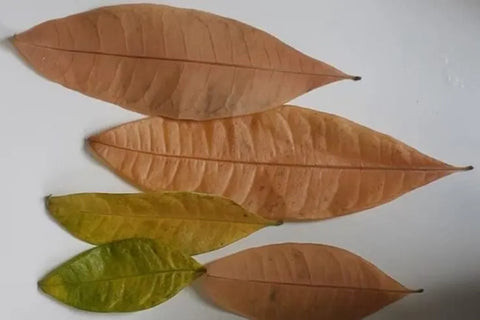 Money tree leaves turning yellow due to overwatering
Money tree leaves turning yellow due to overwatering
1.1.1 Solution: How Do You Fix Yellow Leaves on a Money Tree?
- Adjust your watering routine to allow the top inch of soil to dry before rewatering.
- Increase humidity around your money tree by misting its leaves regularly, placing a humidifier nearby, or setting it on a tray with water and pebbles.
- Move your money tree to a location with filtered or indirect sunlight to protect it from sunburn.
- Maintain a stable temperature range of 65-85°F.
- Use natural remedies like insecticidal soap or neem oil to address pest issues.
- If it’s just old age, prune the yellow leaves to encourage new growth.
1.2 What Causes Money Tree Leaves Turning Brown?
Money tree leaves turning brown can be attributed to various factors, with the primary culprit often being inadequate watering practices. Underwatering causes the plant to lose moisture, resulting in dry, brown edges and eventually affecting the entire leaf. Conversely, overwatering can drown the roots, leading to rot, which manifests as brown, mushy leaves. Inconsistent watering schedules, nutrient deficiencies, and environmental stressors can also cause money tree leaves to turn brown.
 Money tree leaves turning yellow due to overwatering
Money tree leaves turning yellow due to overwatering
1.2.1 What Do Brown Spots on Money Tree Leaves Mean?
Brown spots on money tree leaves may signify fungal or bacterial infections. These pathogens thrive in humid conditions, resulting from water splashes on leaves or high humidity levels. Additionally, exposure to sudden temperature changes can cause leaf stress, leading to the formation of brown spots. Pest infestations, such as scale insects or spider mites, can lead to localized browning.
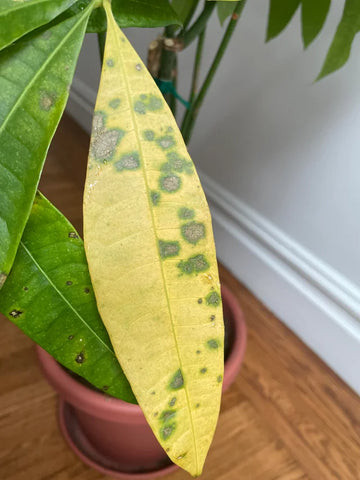 Money tree leaves with brown spots indicating fungal infection
Money tree leaves with brown spots indicating fungal infection
1.2.2 Solution: How Do You Fix Brown Leaves on a Money Tree?
First, follow a consistent watering routine. Allow the top inches of potting soil to dry between waterings to prevent root rot. Trim affected leaves to encourage new growth.
If you suspect fungal or bacterial infections, isolate the plant to prevent the spread and apply a fungicide or bactericide as directed. Maintain a stable environment, avoiding cold drafts and sudden temperature changes.
Then, regularly inspect your plant for pests, and if they are found, treat them with appropriate measures such as insecticidal soap. Proper care and a conducive environment will aid in the recovery of your money tree’s leaf health.
1.3 Why Are My Money Tree Leaves Turning White?
Money tree leaves turning white can occur due to powdery mildew, a bacterial or fungal infection that thrives in humid conditions. This white, powdery substance forms on the leaves, hindering photosynthesis and affecting the plant’s health. Other factors like pests, e.g., scale insects or spider mites, can also cause leaves to turn white as they feed on the plant’s vital nutrients.
 Money tree leaves turning white due to powdery mildew
Money tree leaves turning white due to powdery mildew
According to research from New York University’s Stern School of Business, maintaining proper humidity levels is crucial for preventing powdery mildew and other fungal infections in indoor plants.
1.3.1 What Do White Spots on Money Tree Leaves Indicate?
White spots on a money tree indicate that the plant is being burnt in direct sunlight. It also shows insect infestation, micronutrient deficiency, and the mosaic virus. Moreover, the appearance of white spots suggests the presence of powdery mildew colonies or spores on the leaf surface.
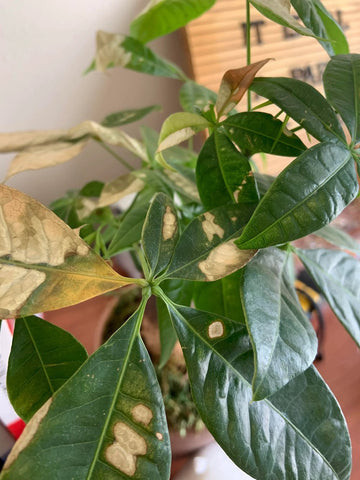 Money tree leaves with white spots from direct sunlight
Money tree leaves with white spots from direct sunlight
1.3.2 Solution: How Do You Treat White Spots on Leaves?
Start by isolating the affected plant to prevent the spread of infection. Remove and dispose of severely affected leaves. If the cause is identified as a fungal or bacterial infection, treat the plant with a suitable fungicide or bactericide following the product’s instructions.
For pest issues, apply natural remedies like neem oil or insecticidal soap. Regularly monitor your money tree for signs of recurrence and maintain a vigilant care routine to promote its overall well-being.
1.4 What Causes Money Tree Leaves Curling: Reasons and Fixes
Your money tree leaves can curl due to various factors, often signaling the plant’s response to environmental stress. Underwatering or inconsistent watering routines may cause the leaves to curl inward as the plant attempts to minimize water loss. Additionally, exposure to direct sunlight or low humidity can induce leaf curling as the plant adjusts to protect itself from adverse conditions. Pests, like scale or spider mites, can also trigger this response by inflicting damage to the leaves. Moreover, money tree leaves curling may occur due to root rot from overwatering as the tree cannot absorb nutrients like Calcium and water for the leaves.
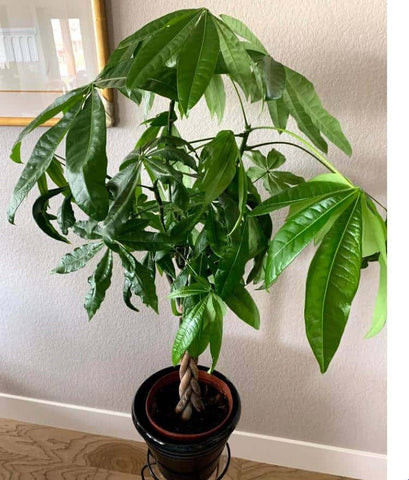 Money tree leaves curling due to underwatering
Money tree leaves curling due to underwatering
1.4.1 Solution: Money Tree Curled Leaves: What to Do
Start by assessing and adjusting your watering practices. Ensure the soil remains moist but well-draining, allowing the top inch to dry between waterings. If the curling is due to exposure to excessive light or drafts, relocate your money tree to a spot with indirect sunlight and away from drafty areas.
Regularly inspect your plant for pests, and if identified, apply suitable treatments such as neem oil or insecticidal soap. Consistent care, proper environmental conditions, and targeted pest control measures will contribute to the restoration of your money tree’s leaf structure.
1.5 Why Is My Money Tree Leaves Droopy?
Money tree leaves drooping is an issue that occurs due to various reasons, reflecting the plant’s response to stress or unfavorable conditions. Here are potential reasons and brief explanations:
- Overwatering: Excessive moisture causes root rot, impacting the plant’s ability to support its leaves.
- Underwatering: Insufficient water supply causes dehydration, causing the leaves to droop as the plant conserves water.
- Incorrect Lighting: Exposure to direct sunlight or inadequate light can stress the plant, leading to drooping leaves.
- Temperature Extremes: Fluctuations between high and low temperatures can stress the money tree, resulting in droopy foliage.
- Root Bound: If the plant has outgrown its pot, it may become root-bound, restricting its ability to absorb water and nutrients.
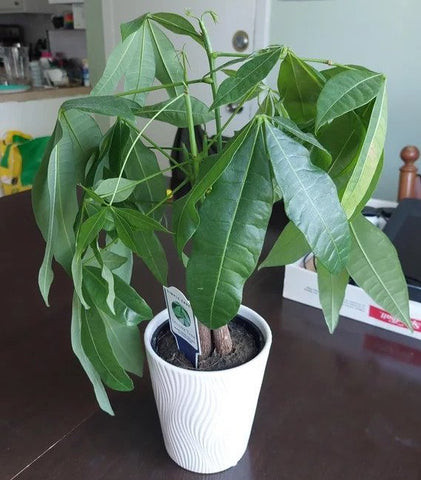 Money tree leaves drooping from overwatering
Money tree leaves drooping from overwatering
1.5.1 Solution: What to Do About Drooping Money Tree Leaves?
- Adjust watering.
- Evaluate lighting conditions.
- Maintain a stable temperature range of 65-85°F.
- Repot your Money Tree plant if root bound.
- Address pest issues.
1.6 What Causes Holes in Money Tree Leaves: Possible Reasons and Solutions
Pests, physical damage, fungal or bacterial infections, nutrient deficiencies, and water quality are possible reasons for holes in money tree leaves.
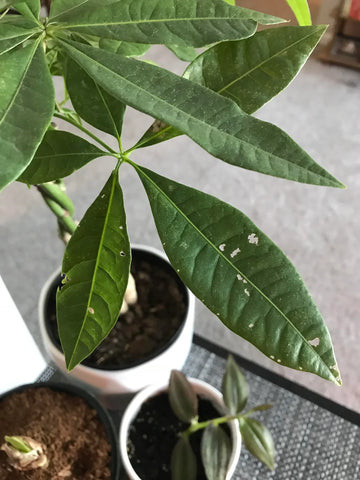 Money tree leaves with holes due to pest infestation
Money tree leaves with holes due to pest infestation
Pests
- Reason: Spider mites, scale insects, or caterpillars can chew through money tree leaves, creating holes.
- Solution: Use natural remedies like insecticidal soap or neem oil to eliminate them. Isolate heavily affected plants to prevent further infestation.
Physical Damage
- Reason: Accidental damage from brushing against sharp objects or pets can cause holes in the leaves.
- Solution: Place your money tree in a safer location away from potential sources of physical harm. Trim damaged leaves to encourage new, healthy growth.
Fungal or Bacterial Infections
- Reason: Diseases such as leaf spot or blight can cause the formation of holes in money tree leaves.
- Solution: Apply a suitable fungicide or bactericide as directed to prevent the spread of the infection.
Nutrient Deficiencies
- Reason: Lack of essential nutrients, especially Calcium, weakens the leaf structure, making them more susceptible to damage.
- Solution: Use a fertilizer with appropriate nitrogen, phosphorus, and potassium ratios to address nutrient deficiencies.
Water Quality
- Reason: Poor water quality, such as high levels of chlorine or fluoride, can contribute to leaf damage and the formation of holes.
- Solution: Use filtered or distilled water for your money tree to prevent exposure to harmful substances. Allow tap water to sit for about a day before using it to let chlorine dissipate.
1.7 What Causes Money Tree Leaves Falling Off: Why and How to Fix
Sudden money tree leaves falling off can cause concern, and several factors may contribute to this issue. Overwatering leads to root rot, dehydration, exposure to extreme temperatures, or a pest infestation can all trigger leaf drop. Also, stress due to changes in lighting conditions, pot-bound roots, or nutrient deficiencies may prompt your money tree to shed its leaves. Identifying the specific cause is crucial for implementing targeted solutions.
 Money tree leaves falling off due to overwatering and root rot
Money tree leaves falling off due to overwatering and root rot
1.7.1 Will the Leaves Grow Back on My Money Tree?
In most cases, if the underlying issue causing leaf drop is addressed promptly, and the overall health of the money tree is restored, new growth will likely emerge. Regular care, proper watering, and attention to environmental conditions will encourage the development of fresh, vibrant leaves.
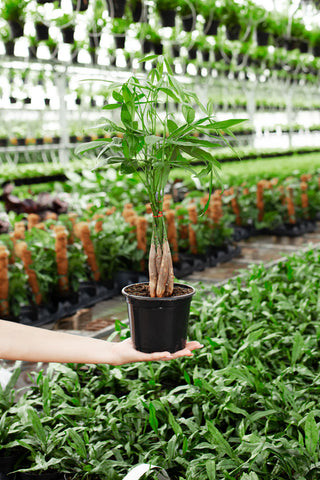 Money tree with new leaves after proper care
Money tree with new leaves after proper care
1.7.2 Solution: How Do You Save a Money Tree Without Leaves?
Avoid overwatering or underwatering, provide filtered or indirect sunlight, and maintain stable lighting to reduce plant stress. If the plant is root-bound or the soil is unhealthy, consider repotting in fresh, well-draining soil. Use a balanced fertilizer to address nutrient deficiencies and promote overall plant health.
2. Proactive Care: Money Tree Leaves Prevention and Care Tips
A proactive and attentive care regimen is essential to maintain the lush vibrancy of your money tree leaves and prevent common issues like sunburn, yellowing, brown spots, white discoloration, drooping, and leaf curling. Here are a few care tips to help you foster a thriving environment for your money tree and ensure its overall well-being:
- Well-Draining Soil: Use a well-draining potting mix to prevent waterlogging and root rot. Money trees prefer slightly moist, not soggy, conditions.
- Balanced Fertilization: Apply a balanced liquid fertilizer every 4-6 weeks during the growing season (spring and summer). This ensures the plant receives essential nutrients for healthy leaf development.
- Appropriate Pot Size: Choose a pot with drainage holes that accommodate the plant’s size, promoting healthy root growth and preventing water stagnation.
- Watering Routine: Water the money tree when the top inch of soil is dry. Avoid overwatering, which can lead to root rot, and underwatering, causing dehydration and leaf issues.
- Indirect Sunlight: Place the money tree in bright, indirect sunlight. Shield it from prolonged exposure to harsh direct sunlight to prevent issues like sunburn.
- Pest and Disease Prevention: Regularly inspect the plant for pests, wipe leaves to remove dust, and isolate infected plants promptly. Implement natural remedies like neem oil for pest control.
According to The Wall Street Journal, consistent monitoring and preventive measures are key to maintaining the health of indoor plants, including money trees.
3. Optimizing Your Financial Health Alongside Your Money Tree
Just like your money tree needs the right conditions to flourish, so does your financial well-being. At money-central.com, we believe in nurturing both your green companions and your financial goals. Here’s how you can draw parallels between plant care and financial management:
- Consistent Care vs. Consistent Saving: Just as your money tree needs regular watering, your savings need consistent contributions.
- Proper Environment vs. Sound Financial Planning: Your money tree thrives in indirect sunlight; similarly, your finances need a well-thought-out plan to avoid “harsh direct sunlight” (risky investments).
- Addressing Issues Promptly vs. Managing Debt: Just as you treat pests on your money tree, tackle debt quickly to prevent it from spreading.
- Investing in Growth vs. Investing in the Market: Use fertilizer for your plant’s growth and invest in stocks or bonds for your financial growth.
- Pruning Dead Leaves vs. Cutting Expenses: Prune dead leaves to save energy and cut unnecessary expenses to save money.
- Adequate Pot Size vs. Growing Your Portfolio: Choose an adequate pot size for healthy root growth, and diversify your portfolio for financial stability.
- Well-Draining Soil vs. Staying Liquid: Use well-draining soil to prevent waterlogging, and avoid tying up all your money in illiquid assets.
For more insights on how to manage your finances like a pro, visit money-central.com and explore our resources on budgeting, saving, and investing.
4. Essential Money Management Tips to Enhance Your Financial Tree
Cultivating a healthy financial life requires attention to detail and consistent effort. Here are several essential tips to help you grow your financial tree:
| Tip | Description | Benefit |
|---|---|---|
| Create a Budget | Track income and expenses to identify where your money is going. Use budgeting apps or spreadsheets. | Gain control over your finances, identify areas to save, and allocate funds effectively. |
| Set Financial Goals | Define short-term and long-term financial objectives, such as saving for a down payment, retirement, or debt repayment. | Provide direction and motivation for your financial efforts, making it easier to stay on track. |
| Build an Emergency Fund | Save 3-6 months’ worth of living expenses in a readily accessible account. | Protect against unexpected financial setbacks, such as job loss, medical emergencies, or car repairs. |
| Pay Down High-Interest Debt | Prioritize paying off debts with the highest interest rates, such as credit card debt or personal loans. | Reduce the total amount of interest paid over time, freeing up funds for saving and investing. |
| Invest Early and Consistently | Start investing as early as possible and contribute regularly to maximize the power of compounding. Consider stocks, bonds, mutual funds, and retirement accounts. | Grow your wealth over the long term, achieve financial independence, and secure your future. |
| Diversify Investments | Spread your investments across different asset classes, industries, and geographic regions to reduce risk. | Protect your portfolio against market volatility and potential losses, increasing the likelihood of long-term success. |
| Automate Savings | Set up automatic transfers from your checking account to your savings or investment accounts each month. | Make saving effortless, consistent, and less prone to impulse spending. |
| Review and Adjust Regularly | Periodically review your budget, financial goals, and investment portfolio to ensure they align with your current circumstances and objectives. Make adjustments as needed. | Stay on track with your financial plan, adapt to changing life events, and optimize your strategies for maximum effectiveness. |
| Seek Professional Advice | Consider consulting a financial advisor for personalized guidance on budgeting, saving, investing, and retirement planning. | Gain expert insights, make informed decisions, and develop a comprehensive financial plan tailored to your unique needs and goals. |
| Monitor Credit Report | Regularly review your credit report for errors and signs of identity theft. Dispute any inaccuracies promptly. | Maintain a good credit score, protect against fraud, and ensure accurate credit information is used by lenders and creditors. |
| Plan for Retirement | Start planning for retirement early by estimating your future expenses and determining how much you need to save. Utilize retirement accounts like 401(k)s and IRAs. | Secure your financial future, enjoy a comfortable retirement, and avoid financial stress in your later years. |
| Learn Financial Literacy | Continuously educate yourself about personal finance topics, such as budgeting, investing, taxes, and retirement planning. | Make informed financial decisions, avoid costly mistakes, and take control of your financial well-being. |
| Avoid Lifestyle Inflation | Be mindful of lifestyle inflation, where increased income leads to increased spending. Resist the urge to upgrade your lifestyle excessively as your income rises. | Maintain a healthy savings rate, build wealth, and avoid getting trapped in a cycle of spending more as you earn more. |
| Tax Planning | Plan your finances to minimize your tax liability through strategies like tax-advantaged accounts, deductions, and credits. | Reduce your tax burden, increase your disposable income, and maximize your wealth accumulation. |
| Regularly Review Insurance | Review your insurance policies (health, auto, home, life) to ensure you have adequate coverage and are paying competitive rates. | Protect yourself and your assets against unforeseen events, manage risk effectively, and avoid overpaying for insurance. |
By following these tips, you can cultivate a thriving financial tree that provides security, growth, and prosperity for years to come.
5. Stay Updated with the Latest Financial News
Staying informed about the latest financial news and market trends is crucial for making sound financial decisions. Here’s a table with some of the most important recent financial updates in the USA:
| Date | Event | Impact |
|---|---|---|
| October 2024 | Federal Reserve holds interest rates steady at 5.25%-5.50%. | This decision aims to balance inflation control with economic stability. The stock market may experience volatility as investors react to the Fed’s assessment. |
| November 2024 | Midterm elections may lead to policy shifts affecting sectors like healthcare and energy. | The election outcomes could cause significant market fluctuations and influence the direction of economic policy. |
| December 2024 | Holiday retail sales data is released. | A strong holiday season could boost economic growth, while weak sales may signal a slowdown. |
| January 2025 | New inflation data is released. | Inflation trends will heavily influence the Federal Reserve’s future policy decisions and market expectations. |
| February 2025 | President’s State of the Union address outlines economic priorities. | The speech may provide insights into upcoming legislative actions and their potential impact on businesses and consumers. |
| March 2025 | First quarter GDP growth is announced. | This provides a snapshot of the economy’s health and can affect investment strategies and business planning. |
Remember to stay informed through reliable sources like Bloomberg, Forbes, and The Wall Street Journal.
6. Money Tree Leaves Issues: FAQs
6.1 Why does my money tree lose its leaves?
A: Money trees may shed leaves due to overwatering, underwatering, exposure to extreme temperatures, pests, or environmental stress. Identifying and addressing the root cause is crucial for preventing further leaf loss.
6.2 Should I cut dying leaves off my money tree?
A: Yes. Removing dying or yellow leaves helps redirect the plant’s energy to healthy growth. Use clean, sharp scissors to trim leaves at the base and prune them regularly to promote overall plant vitality.
6.3 Can you save a dehydrated money tree?
A: You can save a dehydrated money tree by thoroughly watering the soil and providing a humid environment. Gradually reintroduce it to regular care routines, ensuring proper hydration and recovery.
6.4 How often should I water my money tree?
A: Water your money tree when the top inch of soil feels dry, typically every 1-2 weeks. The frequency depends on environmental conditions, pot size, and plant size. Adjust watering to prevent both overwatering and underwatering.
6.5 What kind of light does a money tree need?
A: Money trees thrive in bright, indirect sunlight. Avoid placing them in direct sunlight, as this can scorch their leaves.
6.6 How do I know if my money tree has root rot?
A: Signs of root rot include yellowing leaves, a musty odor coming from the soil, and mushy, brown roots.
6.7 How can I increase humidity for my money tree?
A: You can increase humidity by misting the leaves regularly, placing a humidifier nearby, or setting the plant on a tray filled with water and pebbles.
6.8 What are common pests that affect money trees?
A: Common pests include spider mites, mealybugs, and scale insects.
6.9 How do I get rid of pests on my money tree?
A: You can treat pests with insecticidal soap, neem oil, or by wiping the leaves with a damp cloth.
6.10 How often should I fertilize my money tree?
A: Fertilize your money tree every 4-6 weeks during the growing season (spring and summer) with a balanced liquid fertilizer.
Conclusion: Nurturing Growth, Both Green and Financial
Nurturing a healthy and vibrant money tree requires a keen understanding of its unique needs. Yellowing leaves signal overwatering or insufficient humidity, while browning may result from pests or environmental stress. Fungal infections can lead to white discoloration, and drooping may be a response to watering or environmental factors. Curling leaves often indicate pest presence or inadequate care.
Timely identification and targeted solutions for these issues are vital in restoring your money tree’s vitality. Remember, a well-balanced care routine, from proper watering to providing the right lighting, is your recipe for a thriving indoor oasis. Consider companion plants like snake plants or ZZ plants to complement your money tree and enhance the greenery in your space.
Just as you care for your money tree, money-central.com is here to help you cultivate your financial well-being. Visit our website for more articles, tools, and expert advice to achieve your financial goals. You can also contact us at Address: 44 West Fourth Street, New York, NY 10012, United States. Phone: +1 (212) 998-0000. Let’s grow together!